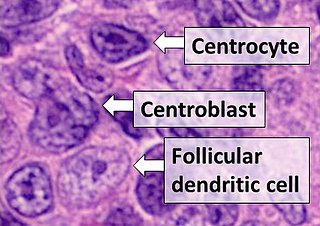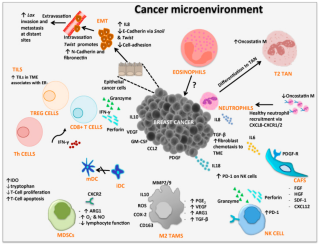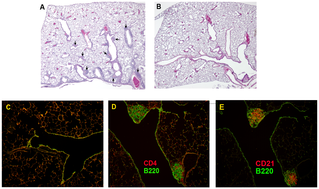Related Research Articles

Dendritic cells (DCs) are antigen-presenting cells of the mammalian immune system. Their main function is to process antigen material and present it on the cell surface to the T cells of the immune system. They act as messengers between the innate and the adaptive immune systems.

Complement receptor type 1 (CR1) also known as C3b/C4b receptor or CD35 is a protein that in humans is encoded by the CR1 gene.

Langerhans cells (LC) are tissue-resident macrophages of the skin, and contain organelles called Birbeck granules. They are present in all layers of the epidermis and are most prominent in the stratum spinosum. They also occur in the papillary dermis, particularly around blood vessels, as well as in the mucosa of the mouth, foreskin, and vaginal epithelium. They can be found in other tissues, such as lymph nodes, particularly in association with the condition Langerhans cell histiocytosis (LCH).
Gut-associated lymphoid tissue (GALT) is a component of the mucosa-associated lymphoid tissue (MALT) which works in the immune system to protect the body from invasion in the gut.

The marginal zone is the region at the interface between the non-lymphoid red pulp and the lymphoid white-pulp of the spleen.

Follicular dendritic cells (FDC) are cells of the immune system found in primary and secondary lymph follicles of the B cell areas of the lymphoid tissue. Unlike dendritic cells (DC), FDCs are not derived from the bone-marrow hematopoietic stem cell, but are of mesenchymal origin. Possible functions of FDC include: organizing lymphoid tissue's cells and microarchitecture, capturing antigen to support B cell, promoting debris removal from germinal centers, and protecting against autoimmunity. Disease processes that FDC may contribute include primary FDC-tumor, chronic inflammatory conditions, HIV-1 infection development, and neuroinvasive scrapie.

The "C" sub-family of chemokine receptors contains only one member: XCR1, the receptor for XCL1 and XCL2.
Peripheral tolerance is the second branch of immunological tolerance, after central tolerance. It takes place in the immune periphery. Its main purpose is to ensure that self-reactive T and B cells which escaped central tolerance do not cause autoimmune disease. Peripheral tolerance prevents immune response to harmless food antigens and allergens, too.

Cancer immunology is an interdisciplinary branch of biology that is concerned with understanding the role of the immune system in the progression and development of cancer; the most well known application is cancer immunotherapy, which utilises the immune system as a treatment for cancer. Cancer immunosurveillance and immunoediting are based on protection against development of tumors in animal systems and (ii) identification of targets for immune recognition of human cancer.

Intercellular adhesion molecule 3 (ICAM3) also known as CD50, is a protein that in humans is encoded by the ICAM3 gene. The protein is constitutively expressed on the surface of leukocytes, which are also called white blood cells and are part of the immune system. ICAM3 mediates adhesion between cells by binding to specific integrin receptors. It plays an important role in the immune cell response through its facilitation of interactions between T cells and dendritic cells, which allows for T cell activation. ICAM3 also mediates the clearance of cells undergoing apoptosis by attracting and binding macrophages, a type of cell that breaks down infected or dying cells through a process known as phagocytosis, to apoptotic cells.

Dame Fiona Magaret Powrie is currently the head of the Kennedy Institute of Rheumatology at the University of Oxford. Formerly she was the inaugural Sidney Truelove Professor of Gastroenterology at the University of Oxford. She is also head of the Experimental Medicine Division of the Nuffield Department of Clinical Medicine.

Interleukin 23 (IL-23) is a heterodimeric cytokine composed of an IL-12B (IL-12p40) subunit and an IL-23A (IL-23p19) subunit. IL-23 is part of the IL-12 family of cytokines. The functional receptor for IL-23 consists of a heterodimer between IL-12Rβ1 and IL-23R.
Tolerogenic therapy aims to induce immune tolerance where there is pathological or undesirable activation of the normal immune response. This can occur, for example, when an allogeneic transplantation patient develops an immune reaction to donor antigens, or when the body responds inappropriately to self antigens implicated in autoimmune diseases. It must provide absence of specific antibodies for exactly that antigenes.

Bronchus-associated lymphoid tissue (BALT) is a tertiary lymphoid structure. It is a part of mucosa-associated lymphoid tissue (MALT), and it consists of lymphoid follicles in the lungs and bronchus. BALT is an effective priming site of the mucosal and systemic immune responses.
Franca Ronchese is an Italian-New Zealand immunologist. She currently leads the immune cell biology programme at the Malaghan Institute of Medical Research in Wellington, New Zealand and is a research professor at Victoria University of Wellington.
Antigen transfer in the thymus is the transmission of self-antigens between thymic antigen-presenting cells which contributes to the establishment of T cell central tolerance.
Tolerogenic dendritic cells are heterogenous pool of dendritic cells with immuno-suppressive properties, priming immune system into tolerogenic state against various antigens. These tolerogenic effects are mostly mediated through regulation of T cells such as inducing T cell anergy, T cell apoptosis and induction of Tregs. Tol-DCs also affect local micro-environment toward tolerogenic state by producing anti-inflammatory cytokines.
Jean Sylvia Marshall, born in Birmingham, England, is a Canadian immunologist and acting Professor and Head of the Department of Microbiology & Immunology at Dalhousie University in Halifax, Nova Scotia, Canada. Marshall's work has investigated how mast cells are involved in the early immune response to infection and antigen. She is best known for her discovery of the previously unknown degranulation-independent immunoregulatory roles of mast cells in infection and allergy and their ability to mobilize dendritic cells.

Gwendalyn J. Randolph is an American immunologist, the Emil R. Unanue Distinguished Professor in the Department of Immunology and Pathology at Washington University in St. Louis, Missouri, where she is currently co-director of the Immunology Graduate Program. During her postdoctoral work, Randolph characterized monocyte differentiation to dendritic cells and macrophages and made advances in our understanding of dendritic cell trafficking and the fate of monocytes recruited to sites of inflammation. Her lab has contributed to the Immunological Genome Project by characterizing macrophage gene expression. Her work now focuses on the immunological mechanisms driving atherosclerosis and inflammatory bowel disease (IBD) by exploring lymphatic function and lipoprotein trafficking.
George Bellamy Mackaness was an Australian professor of microbiology, immunologist, writer and administrator, who researched and described the life history of the macrophage. He showed that by infecting mice with intracellular bacteria, macrophages could be activated to attack other bacteria, triggering further research on "macrophage activation", a term he has come to be associated with.
References
- ↑ Iwasaki, Akiko (1 April 2007). "Mucosal Dendritic Cells". Annual Review of Immunology. 25 (1): 381–418. doi:10.1146/annurev.immunol.25.022106.141634. PMID 17378762.
- ↑ Huang, Fang-Ping; Platt, Nicholas; Wykes, Michelle; Major, James R.; Powell, Timothy J.; Jenkins, Christopher D.; MacPherson, G. Gordon (7 February 2000). "A Discrete Subpopulation of Dendritic Cells Transports Apoptotic Intestinal Epithelial Cells to T Cell Areas of Mesenteric Lymph Nodes". Journal of Experimental Medicine. 191 (3): 435–444. doi:10.1084/jem.191.3.435. PMC 2195813 . PMID 10662789.